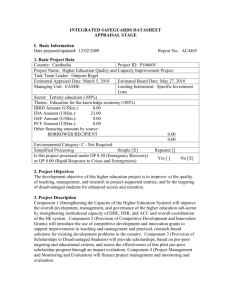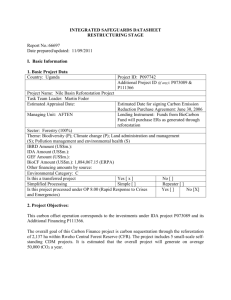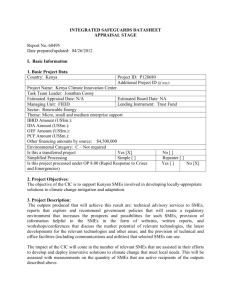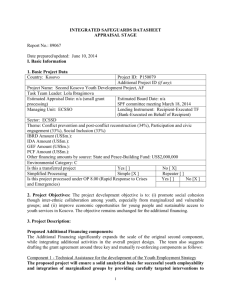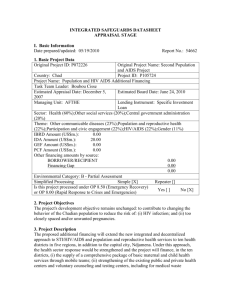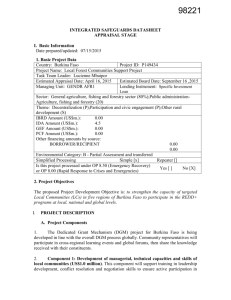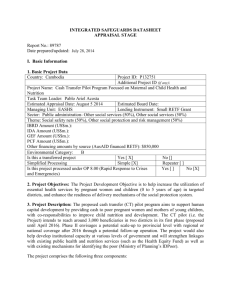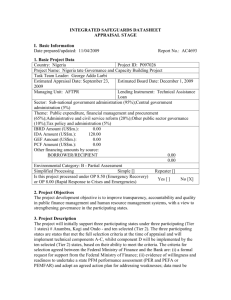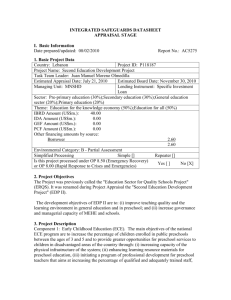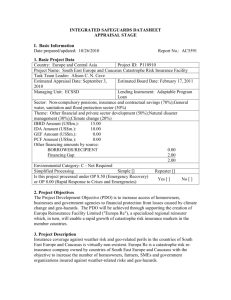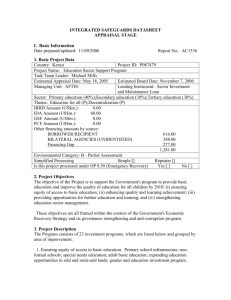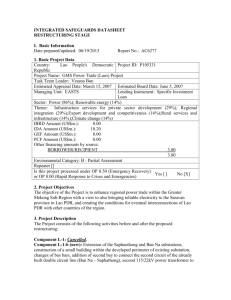integrated safeguards datasheet - Documents & Reports
advertisement
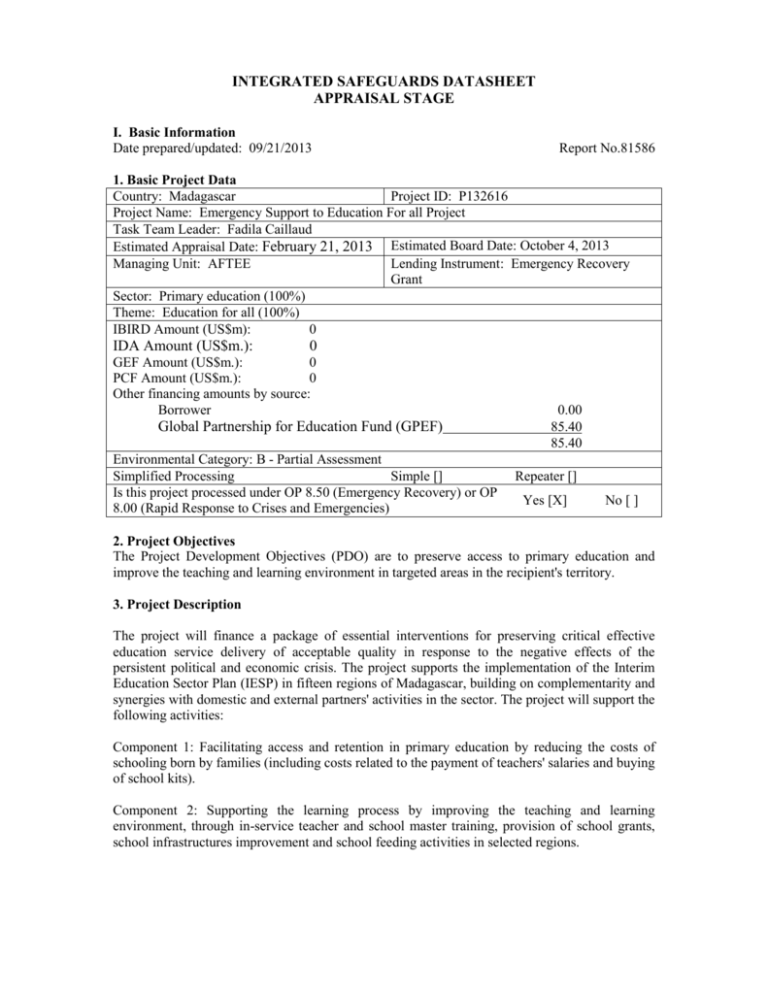
INTEGRATED SAFEGUARDS DATASHEET APPRAISAL STAGE I. Basic Information Date prepared/updated: 09/21/2013 Report No.81586 1. Basic Project Data Country: Madagascar Project ID: P132616 Project Name: Emergency Support to Education For all Project Task Team Leader: Fadila Caillaud Estimated Appraisal Date: February 21, 2013 Estimated Board Date: October 4, 2013 Managing Unit: AFTEE Lending Instrument: Emergency Recovery Grant Sector: Primary education (100%) Theme: Education for all (100%) IBIRD Amount (US$m): 0 IDA Amount (US$m.): 0 GEF Amount (US$m.): 0 PCF Amount (US$m.): 0 Other financing amounts by source: Borrower Global Partnership for Education Fund (GPEF) Environmental Category: B - Partial Assessment Simplified Processing Simple [] Is this project processed under OP 8.50 (Emergency Recovery) or OP 8.00 (Rapid Response to Crises and Emergencies) 0.00 85.40 85.40 Repeater [] Yes [X] No [ ] 2. Project Objectives The Project Development Objectives (PDO) are to preserve access to primary education and improve the teaching and learning environment in targeted areas in the recipient's territory. 3. Project Description The project will finance a package of essential interventions for preserving critical effective education service delivery of acceptable quality in response to the negative effects of the persistent political and economic crisis. The project supports the implementation of the Interim Education Sector Plan (IESP) in fifteen regions of Madagascar, building on complementarity and synergies with domestic and external partners' activities in the sector. The project will support the following activities: Component 1: Facilitating access and retention in primary education by reducing the costs of schooling born by families (including costs related to the payment of teachers' salaries and buying of school kits). Component 2: Supporting the learning process by improving the teaching and learning environment, through in-service teacher and school master training, provision of school grants, school infrastructures improvement and school feeding activities in selected regions. Component 3: Strengthening the foundations of the primary education system by rebuilding the planning and monitoring capacity at central and deconcentrated levels and improving community participation and transparency. 4. Project Location and salient physical characteristics relevant to the safeguard analysis The project targets 15 of the 22 regions. The 12 primary project regions are the following (except for the school feeding activities): ALAOTRA MANGORO, ANALAMANGA, ATSINANANA, BETSIBOKA, BOENY, BONGOLAVA, DIANA, IHOROMBE, ITASY, MELAKY, SOFIA, VAKINANKARATRA. School feeding activities only will be implemented in three other regions where needs are greatest, notably Atsimo Andrefana, Androy, Anosy. 5. Environmental and Social Safeguards Specialists Mr Paul-Jean Feno (AFTN1) Mr Cheikh A. T. Sagna (AFTCS) 6. Safeguard Policies Triggered Environmental Assessment (OP/BP 4.01) Natural Habitats (OP/BP 4.04) Forests (OP/BP 4.36) Pest Management (OP 4.09) Physical Cultural Resources (OP/BP 4.11) Indigenous Peoples (OP/BP 4.10) Involuntary Resettlement (OP/BP 4.12) Safety of Dams (OP/BP 4.37) Projects on International Waterways (OP/BP 7.50) Projects in Disputed Areas (OP/BP 7.60) Yes X No X X X X X X X X X II. Key Safeguard Policy Issues and Their Management A. Summary of Key Safeguard Issues 1. Describe any safeguard issues and impacts associated with the proposed project. Identify and describe any potential large scale, significant and/or irreversible impacts: The proposed Emergency Support to Education for All Projects is classified as an environmental and social Category B since activities funded under the project are not expected to have significant negative environmental and/or social impacts. In fact, parts of the activities described within the proposed operation will focus on capacity building and training, material and equipment procurements, and institutional reform where no environmental and social safeguard aspect would be expected. The proposed Grant will also plan to finance the construction of new classrooms, and the rehabilitation, reconstruction or retrofitting of existing schools to meet school construction norms, which could produce some adverse negative impacts. The negative impacts would be minor and manageable with a minimum of effort and pose with a relatively low risk of involuntary resettlement or land acquisition. No large scale, significant or irreversible negative impact is foreseen to be induced by the project activities and the project will not finance activities that affect physical cultural resources. Two safeguards policies are triggered: OP/BP 4.01 (Environmental Assessment) and OP/BP 4.12 (Involuntary Resettlement). However, to help manage any environmental and social issues at the early stage of the project implementation and to ensure consistent treatment of social and environmental issues by all donors and the Government of Madagascar, an Environmental and Social Screening Assessment Framework (ESSAF) was developed (see Annex 9 of the Emergency Project Paper), as the project is processed as an emergency project under Bank operational policy OP 8.00. Within three months of project effectiveness, two safeguards instruments mainly related to subcomponent 2.4 “School infrastructure improvement”, an Environmental and Social Management Framework and a Resettlement Policy Framework (ESMF and RPF) will be prepared, discussed in consultations and disclosed in-country and at the Bank’s Infoshop. This will constitute a disbursement condition for this subcomponent. The ESMF and RPF will serve to facilitate the environmental and social management of the activities. 2. Describe any potential indirect and/or long term impacts due to anticipated future activities in the project area: The potential environmental and social impacts are foreseen to be small-scale and site specific, thus easily mitigated. No long term or cumulative impacts are foreseen during project implementation. 3. Describe any project alternatives (if relevant) considered to help avoid or minimize adverse impacts. N/A 4. Describe measures taken by the borrower to address safeguard policy issues. Provide an assessment of borrower capacity to plan and implement the measures described. The ESSAF was developed specifically for this proposed operation to ensure due diligence, to avoid causing harm, and to ensure consistent treatment of social and environmental issues by all donors and the Government of Madagascar. The purpose of this Framework is also to assist the Ministry of Education (MEN) in screening all the subprojects for their likely social and environmental impacts, identifying documentation and preparation requirements and prioritizing the investments. The required Environmental and Social Impact Assessments (ESIAs) and/or Environmental and Social Management Plans (ESMPs) will be undertaken during project implementation in parallel with subproject technical feasibility studies. As proposed in the ESSAF prior to subproject appraisal, the implementing agency will agree to apply the following minimum standards during implementation: inclusion of standard Environmental Codes of Practice (ECOP) in the rehabilitation, improvement and reconstruction bid documents of all subprojects; review and oversight of any major reconstruction works by civil engineers; implementation of environmentally and socially sound options for disposal of debris or drain spoils; and provisions for adequate and satisfactory budget and institutional arrangements for monitoring effective implementation. The need for involuntary resettlement or land acquisition in specific subproject areas will only be known during project implementation, when site-specific plans are available. Several issues will increase the complexity of land acquisition - the lack of reliable land record systems, and the inability of people losing land to either document ownership or be physically present to make their claim for eligibility. Therefore, subprojects will be screened for applicability of the resettlement policy and any subprojects involving involuntary resettlement or land acquisition will only be approved after preparation of a Resettlement Action Plan acceptable to the Bank. The safeguards framework will therefore include procedures for identifying eligible project-affected people, calculating and delivering compensation, and mechanisms for land dispute grievance redress. For the proposed Grant, two required safeguard documents (ESMF and RPF) will be prepared, consulted upon and disclosed publicly both in-country and at the InfoShop no later than three months following the effectiveness date. The project will be coordinated and supervised by the existing project implementation unit, UAT, Unité d'Appui Technique-Education pour Tous (UAT-EPT), which will be responsible for day-to- day project implementation and monitoring of the three components, including all fiduciary aspects, monitoring and evaluation, and safeguards. In this context, all safeguard aspects will be led under the existing UAT which has agreed to nominate a Social and Environmental Focal Point (SEFP) to ensure that all civil works of classroom constructions and rehabilitations will be in compliance with the safeguard environmental and social requirements. The UAT will be supported by the National Office of Environment (NOE) for capacity building to implement mitigation measures as part of the project. The NOE will be also in charge of monitoring and supervising the agreed environmental and social measures of all sub-projects financed by the project. Local government will participate in any consultations, as the case arises, during the preparation of safeguards instruments as well as the implementation of mitigation/compensation measures. Enterprises will be responsible for applying the mitigation requirements proposed by the UAT to each subproject. As part of the capacity-building to be provided for an environmentally-friendly implementation of the proposed project, the technical team within the UAT-EPT will be trained on the Bank's safeguard policies implementation requirements and in the ESSAF's application. 5. Identify the key stakeholders and describe the mechanisms for consultation and disclosure on safeguard policies, with an emphasis on potentially affected people. The ESSAF will be shared with Ministries the directly involved in the project (Environment, Education), local government whose territories will host subprojects, concerned nongovernmental organizations and development partners of Madagascar involved in the education program. It will be disclosed in country and at the World Bank's InfoShop. The RPF and ESMF will also be disclosed in accordance with the Bank guidelines. At any time, as necessary, the UAT-EPT will consult with project-affected groups and local governments on the project's environmental and social aspects, and will take their views into account. The UTA-EPT will initiate these consultations as early as possible, and for meaningful consultations, will provide relevant material in a timely manner prior to consultation, in Malagasy language and a form that is easily understandable and accessible to the groups being consulted. B. Disclosure Requirements Date Environmental Assessment/Audit/Management Plan/Other: Was the document disclosed prior to appraisal? Date of receipt by the Bank Date of "in-country" disclosure Date of submission to InfoShop For category A projects, date of distributing the Executive Summary of the EA to the Executive Directors Resettlement Action Plan/Framework/Policy Process: Was the document disclosed prior to appraisal? Date of receipt by the Bank Date of "in-country" disclosure Date of submission to InfoShop Indigenous Peoples Plan/Planning Framework: Was the document disclosed prior to appraisal? Date of receipt by the Bank Date of "in-country" disclosure Date of submission to InfoShop Pest Management Plan: Was the document disclosed prior to appraisal? Date of receipt by the Bank No N/A N/A N/A Date of "in-country" disclosure Date of submission to InfoShop * If the project triggers the Pest Management and/or Physical Cultural Resources, the respective issues are to be addressed and disclosed as part of the Environmental Assessment/Audit/or EMP. If in-country disclosure of any of the above documents is not expected, please explain why: Due to the emergency nature of this operation, and in compliance with OP/BP 8.00, the completion and disclosure of the environmental and social instruments fall under the 6-month "Grace Period" during which time they are not required as a condition for project appraisal. However, an Environmental and Social Screening and Assessment Framework (ESSAF) was prepared and will be disclosed at the Infoshop as well as in-country during project implementation. Additionally, the RPF and ESMF, to be prepared within three months of project effectiveness, will also be disclosed in accordance with Bank guidelines. C. Compliance Monitoring Indicators at the Corporate Level (to be filled in when the ISDS is finalized by the project decision meeting) OP/BP/GP 4.01 - Environment Assessment Does the project require a stand-alone EA (including EMP) report? If yes, then did the Regional Environment Unit or Sector Manager (SM) review and approve the EA report? Are the cost and the accountabilities for the EMP incorporated in the credit/loan? OP/BP 4.12 - Involuntary Resettlement Has a resettlement plan/abbreviated plan/policy framework/process framework (as appropriate) been prepared? If yes, then did the Regional unit responsible for safeguards or Sector Manager review the plan? The World Bank Policy on Disclosure of Information Have relevant safeguard policies documents been sent to the World Bank's Infoshop? Have relevant documents been disclosed in-country in a public place in a form and language that are understandable and accessible to project-affected groups and local NGOs? All Safeguard Policies Have satisfactory calendar, budget and clear institutional responsibilities been prepared for the implementation of measures related to safeguard policies? Have costs related to safeguard policy measures been included in the project cost? Does the Monitoring and Evaluation system of the project include the monitoring of safeguard impacts and measures related to safeguard policies? Have satisfactory implementation arrangements been agreed with the borrower and the same been adequately reflected in the project legal documents? N/A No No No No Yes Yes Yes Yes D. Approvals Signed and submitted by: Task Team Leader: Environmental Specialist: Social Development Specialist Additional Environmental and/or Social Development Specialist(s): Approved by: Regional Safeguards Coordinator: Comments: Sector Manager: Comments: Name Ms Fadila Caillaud Mr Paul-Jean Feno Mr Cheikh A. T. Sagna Ms Alexandra C. Bezeredi Ms Sajitha Bashir Date 01/11/2013 01/11/2013 01/11/2013
